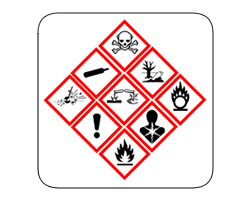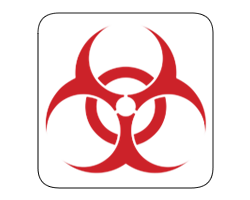Training by Subject
Laboratory Safety
To simplify training assignment and compliance reporting, EHS offers three groups of commonly required lab safety courses. Select the one track that corresponds to the risks in your lab, in lieu of several individual tracks. Supervisors can contact ORRS.train@msu.edu for assistance removing individual tracks from employees and transitioning to using Lab Safety tracks.
Which lab safety track is right for me? (PDF)
 Option 1: Lab Safety-Basics Track
Option 1: Lab Safety-Basics Track
For work in laboratories with chemicals but no biological safety risks. Includes courses:
- Chemical Hygiene
- Hazardous Waste
- Compressed Gas Cylinder Safety
- Cryogen Safety
- Laboratory Security Awareness
- Asbestos for the Lab Setting
- Site-Specific Safety Training
 Option 2: Lab Safety-Basics+Biological Track
Option 2: Lab Safety-Basics+Biological Track
For work in laboratories with infectious agents; live animals; recombinant DNA; etc. Includes courses:
- Biological Safety and Security (required general module, optional animal and plant modules)
- Biohazardous Waste
- Autoclave Safety
- Chemical Hygiene
- Hazardous Waste
- Compressed Gas Cylinder Safety
- Cryogen Safety
- Laboratory Security Awareness
- Asbestos for the Lab Setting
- Site-Specific Safety Training
 Option 3: Lab Safety-Basics, Biological + Bloodborne Track
Option 3: Lab Safety-Basics, Biological + Bloodborne Track
For work in laboratories with bloodborne pathogens; human cell lines; etc. Includes courses:
- Biological Safety and Security (required general module, optional animal and plant modules)
- Bloodborne Pathogens
- Biohazardous Waste
- Autoclave Safety
- Chemical Hygiene
- Hazardous Waste
- Compressed Gas Cylinder Safety
- Cryogen Safety
- Laboratory Security Awareness
- Asbestos for the Lab Setting
- Site-Specific Safety Training
Chemical Safety
- Chemical Hygiene, Haz Waste
- Compressed Gases, Cryogens
- Formaldehyde
- Fume Hoods
- Hazardous Drugs
- Methylene Chloride (CDM)
- Sharps (non-biohazard)
Lab workers: see Lab Safety tracks. This subject is included in all three Lab Safety tracks.
Other workers handling hazardous chemicals:
- Add the Chemical Hygiene & Hazardous Waste track to your profile.
- Follow prompts under "My Requirements" to complete courses.
Lab workers: see Lab Safety tracks. This course is included in all three Lab Safety tracks.
Workers outside of labs can complete the courses one-time course:
Required if working in human or veterinary anatomy labs (or related anatomy spaces where formalin preserved tissue is used):
- Add the Formaldehyde Safety track to your profile.
- Follow prompts under "My Requirements" to complete course.
Supplemental, optional safety instruction for fume hood users
Recommended for human and veterinary healthcare personnel working with or near hazardous drugs, including chemotherapy agents:
- Add the Safe Handling Of Hazardous Drugs track to your profile.
- Follow prompts under "My Requirements" to complete course.
Required if working with or around methylene chloride:
- Add the Methylene Chloride track to your profile.
- Follow prompts under "My Requirements" to complete course.
Required if using sharps (needles, syringes, Pasteur pipettes, microscope slides) in a non-medical/non-biohazard setting:
- Add the Non-Clinical Medical Sharps Laboratory track to your profile.
- Follow prompts under "My Requirements" to complete course.
Biosafety
Lab workers - see Lab Safety tracks. This subject is included in the Lab Safety tracks.
Others operating an autoclave or supervising an autoclave operator:
- Add the Autoclave Safety track to your profile.
- Follow prompts under "My Requirements" to complete course.
Lab workers: see Lab Safety tracks. This subject is included in the Lab Safety tracks.
Other workers in environments at Biosafety Level 1 or higher:
- Add the Biosafety Principles track to your profile.
- Follow prompts under "My Requirements" to complete courses
MSU EMPLOYEES IN LABS at risk for occupational exposure to human blood or other human potentially infectious materials: see Lab Safety tracks. This subject is included in the Lab Safety tracks.
MSU EMPLOYEES IN CLINICS at risk for occupational exposure to human blood or other human potentially infectious materials:
- Add the Bloodborne Pathogen track to your profile.
- Follow prompts under "My Requirements" to complete courses.
RHS, IPF, and MSU Police employees - check with your supervisor to confirm required training/ see if department specific instructor-led training is required.
NON-MSU RESIDENTS at risk for occupational exposure to human blood or other human potentially infectious materials:
- Add the Bloodborne Pathogen - NON-MSU Residents & Fellows track to your profile.
- Follow prompts under "My Requirements" to complete course.
UNPAID STUDENTS working around human blood or other human potentially infectious materials:
- Add the Bloodborne Pathogen - Awareness track to your profile.
- Follow prompts under "My Requirements" to complete course.
Required if routinely shipping of biological materials and/or packages containing dry ice.
- Add the Biological Substance Shipping track to your profile.
- Follow prompts under "My Requirements" to complete course.
Required for principal investigators involved in Recombinant or Synthetic Nucleic Acid Molecule Research:
- Add the Principal Investigators at NIH-Funded Institutions track to your profile.
Required for healthcare professionals if there is any chance of having contact with patients.
- Add the Tuberculosis track to your profile.
- Follow prompts under "My Requirements" to complete course.
Animal Handlers
- Controlled Substances
- Occ Health & Safety for Students
- Pharmaceuticals, Medical Materials, Feed
- Primates
- Waste Management at VMC
- Veterinary
Required if using or have access to controlled substances:
- Add the Controlled Substances track to your profile.
- Follow prompts under "My Requirements" to complete course.
Required for academic students who come into contact with live animals during a course:
- Complete course: Occupational Health And Safety For Academic Students
Recommended if involved in research with live animals:
- Complete course: Disposal Of Pharmaceuticals; Other Medical Materials, And Feed
Required if working with non-human primate materials, such as monkey cell lines or tissues.
- Add the Non-Human Primate Materials Biohazard track to your profile.
- Follow prompts under "My Requirements" to complete course.
Required if generating or handling regulated waste at VMC:
- Complete course: Waste Management And Segregation At Veterinary Medical Center
VMC Clinical Basic track: Required for personnel working at the Veterinary Medical Center, all Vet Tech/Vet Nursing students, and all DVM students.
VMC Clinical Safety track: Required for clinicians, technicians, and students working on a Veterinary Medicine Center clinic floor.
See Vet Med Requirements for more details.
Radiation Safety
Radiation Detection Equipment
Required if using Class 3B or Class 4 open beam lasers. Recommended for all laser users:
- Add the Laser Safety track to your profile.
- Follow prompts under "My Requirements" to complete courses.
Required if using radioactive material. Registration instructions
Required if working with gas chromatographs (GC) equipped with radioactive electron capture devices (ECD):
- Add the Radiation Sealed Source track to your profile.
- Follow prompts under "My Requirements" to complete online courses.
Minor Radioactive Material Spill Response
Radiation Safety Surveys
Clinical x-ray devices:
- Add the Clinical X-Ray Safety track to your profile.
- Follow prompts under "My Requirements" to launch online courses.
Analytical x-ray devices:
- Add the Clinical X-Ray Safety track Analytical X-Ray Safety track to your profile.
- Follow prompts under "My Requirements" to launch online courses.
Environment
Asbestos Awareness
Required for maintenance and custodial employees who need to recognize potential asbestos-containing material and damaged ACM:
- Add the Asbestos Awareness track to your profile.
- Follow prompts under "My Requirements" to register for or launch online courses:
- Asbestos Awareness (2 HR In Person Training)
- Follow prompts under "My Requirements" to register for in person training. If no events are scheduled, contact EHS Environmental Safety.
- Annual Refresher Training
- Follow prompts under "My Requirements" to launch online course.
- Asbestos Awareness (2 HR In Person Training)
Asbestos Operations & Maintenance
Required for employees who perform maintenance operations where asbestos-containing material is likely to be disturbed:
- Add the Asbestos O&M track to your profile.
- Follow prompts under "My Requirements" to register for in person training. If no events are scheduled, contact EHS Environmental Safety.
Required if involved in maintenance activities that may impact coated surfaces, including paint, primer, varnish, and shellac:
- Add the MIOSHA Metals Awareness track to your profile.
- Complete courses:
- MIOSHA Metals Awareness (first year)
- Follow prompts under "My Requirements" to register for in person training. If no events are scheduled, contact EHS Environmental Safety.
- MIOSHA Metals Awareness Refresher (annually, after first year)
- Follow prompts under "My Requirements" launch online course
- MIOSHA Metals Awareness (first year)
Required if managing petroleum products and chemicals in a non-laboratory setting:
- Add the SPCC/PIPP Management track to your profile.
- Follow prompts under "My Requirements" to launch online course (annually).
Recommended for personnel whose job duties may impact storm water:
- Complete course: Storm Water Protection
Management practices and safety measures to protect water in MSU's Wellhead Protection area:
- Complete course: Well-Head Protection Program
Occupational Safety
- Abrasive Blasting Cabinet
- Aerial Lift
- Back Safety
- Chain Hoists
- Confined Space
- Fork Truck
- Hand Tools
- Hazard Communication
- Hearing Conservation
- Ladders
- Lockout Tagout
- Non-Regulated Vehicles
- Overhead Crane
- Pesticides (WPS) (Agriculture)
- Powered Low Lift
- Respirators
- Silica
- Thermal Stress
- Tractors
Required if using blasting cabinet:
- Complete course: Abrasive Blasting Cabinet Safety
Required if using a personal lift, scissor lift or boom lift, including truck mounted lifts:
- Add the Aerial Lift Operator track to your profile.
- Complete courses (every three years):
- Aerial Lift Operator Tutorial
- Follow prompts under "My Requirements" to register for or launch online course
- Aerial Lift Hands-On
- Schedule with EHS Occupational Safety or on-site authorized trainer
- Aerial Lift Operator Tutorial
Recommended for anyone who lifts as part of their job:
- Complete course: Back Safety
Required if operating an overhead hoist, whether powered or manual:
- Complete course: Chain Hoists Safety
Required if entering confined spaces:
- Add the Confined Space track track to your profile.
- Complete courses:
- Confined Space Tutorial
- Follow prompts under "My Requirements" to launch online course
- Confined Space Hands-On
- Schedule with EHS Occupational Safety or on-site authorized trainer
- Confined Space Tutorial
Required if operating warehouse, rough terrain type fork trucks:
- Add the Fork Truck Operator Permit track to your profile.
- Complete courses every three years:
- Fork Truck Operator Tutorial
- Follow prompts under "My Requirements" to launch online course
- Fork Truck Hands-On
- Schedule with EHS Occupational Safety or on-site authorized trainer
- Fork Truck Operator Tutorial
Required if authorized to conduct on-site fork truck evaluations:
- Add the Fork Truck Train-the-Trainer track to your profile.
- Complete training every three years:
- Fork Truck Train-the-Trainer - first year
- Schedule with EHS Occupational Safety or on-site authorized trainer
- Fork Truck Train-the-Trainer Refresher - annually after first year
- Follow prompts under "My Requirements" to launch online course
- Fork Truck Train-the-Trainer - first year
Required if using powered hand tools.
- Complete course: Hand and Portable Power Tools
Required if working around hazardous chemicals in a non-laboratory setting.
- Add the Hazard Communication track to your profile.
- Follow prompts under "My Requirements" to launch online course:
- Hazard Communication
Required if receiving annual audiometric testing:
- Add the Hearing Conservation track to your profile.
- Follow prompts under "My Requirements" to launch online course:
- Hearing Conservation Program (annually)
Required if using a portable ladder:
- Complete online course: Ladder Safety
Required if servicing equipment on which the unexpected release of hazardous energy could cause injury:
- Complete online course: Lock Out Tag Out
Required if operating a machine on which servicing or maintenance is being performed under lock out or tag out:
- Complete online course: Lock Out Tag Out Affected Employee
Required if using a golf cart, utility cart, skid steer, snowmobile:
- Complete online course: Non-Regulated Vehicles
Required if operating an overhead crane or gantry crane rated 5 tons or more:
- Add the Overhead Crane track to your profile.
- Complete training:
- Overhead Crane (first year)
- Schedule in person with EHS Occupational Safety or on-site authorized trainer.
- Overhead Crane Refresher (annually after first year)
- Follow prompts under "My Requirements" to launch online course.
- Overhead Crane (first year)
Required prior to working in an area that has been treated with pesticides under the EPA Worker Protection Standard (WPS) for agricultural workers. This includes greenhouses and certain forested areas.
- Add the Pesticide Worker Safety (WPS) track to your profile.
- Complete classroom course (annually) - registration instructions for workers
- Arrange site training at least once for each location with the coordinator or manager.
To apply pesticides, you must also have current State Pesticide Applicator license.
Required if using low-lift:
- Add the Powered Low-Lift track to your profile.
- Complete two courses:
- Powered Low-Lift Tutorial
- Follow prompts under "My Requirements" to launch online course.
- Powered Low-Lift Hands-On
- Schedule in-person training with EHS Occupational Safety or on-site authorized trainer.
- Powered Low-Lift Tutorial
Required if wearing a respirator of any type.
- Add the appropriate track(s) to your profile.
- Ensure you are cleared by MSU Occupational Health to wear a respirator (instructions).
- Schedule fit-test (in person).
- Vet Med personnel, contact Vet Med Safety Manager
- All other personnel, select an available appointment in Microsoft Bookings; contact EHS.Respirators@msu.edu with questions
Required if exposed to crystalline silica in the workplace:
- Complete online course: Silica Safety
Required if working in hot or cold environments:
- Complete online course: Thermal Stress
Required if using a tractor:
- Add the Tractor Operator Permit track to your profile.
- Complete two courses, every three years:
- Tractor Operator Tutorial
- Follow prompts under "My Requirements" to launch online course.
- Tractor Hands-On
- Schedule in person with EHS Occupational Safety or on-site authorized trainer.
- Tractor Operator Tutorial

